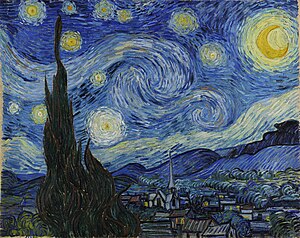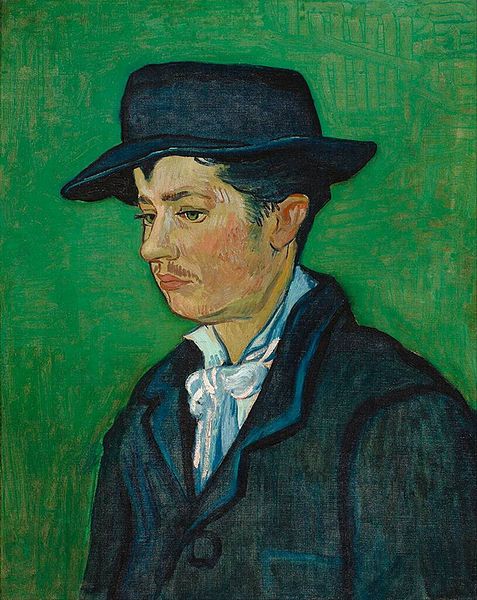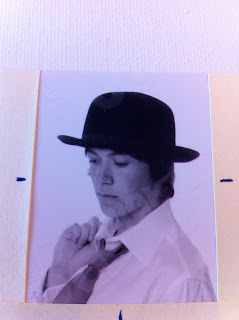
In the dog days of the hottest summer, I thought you might enjoy Vincent's stunning breath of spring....
This is Almond Blossoms (February, 1890), which Vincent painted for his brother, Theo, and Theo's wife, Jo, upon the occasion of the birth of their child.
The painting was completed while Vincent was confined to the asylum at Saint-Remy, where he had gone to recover his mental health and physical strength after the incident where he had cut off his own ear.
| Vincent at Saint-Remy |
| He whom I shall not name |
As they vied for ever higher ratings in the slow summer season, the anchors blathered on and on about what a gifted student this young man was, and what promise he had shown as a middle class boy from a good family who had been gifted with incredible intelligence and every advantage in achieving his full potential.
I knew that I had heard all of this somewhere before. In Van Gogh, The Life, the authors describe an individual of striking similarity.
Vincent was incredibly good at learning things. As a child, he obsessively collected and categorized - bugs, flora, bird's nests - anything that fascinated him was taken home, identified in a neat hand by it's latin name, and treasured, studied, explored and absorbed.
| Vincent |
Vincent was also a loner, and described by many as "een oarige..." a strange boy. He enjoyed solitary walks, and would tramp for hours by himself in all types of weather, including at night and during storms. This was very disturbing to his minister father and "propriety above all" mother. At the tender age of only eleven, his parents had finally had enough of their constant worrying and trying to get Vincent to "be normal," and they sent him away to a boarding school. Although his father did briefly visit him after a few weeks, he did not see the rest of his close knit family again until Christmas. At the age of eleven. Eleven.
This abandonment by his family would prove to have a profound effect on Vincent's life. He likened his time at the school (where he was the youngest and arguably the most intelligent student, as well as a complete outsider) to his time (later, as an adult) in the Asylum at Saint-Remy. After only two years at the first school, his parents, for reasons that probably had to do with money, moved him to a different school, which was even further from their home.
 |
| Vincent with his classmates and instructors - he is on the front row, the third from the right - note his crossed arms, folded body and hat protectively on his knee (from the Van Gogh, the Life website.) |
When he was 15, and only two months away from the end of the school term, Vincent had had enough - He walked out of the school and didn't stop walking until he was home, seven hours later.
Vincent then began his adult life with a series of the lowest entry level jobs, most of which his father helped him to get. First, he apprenticed as an art dealer at his Uncle's company in The Hague, Brussels, London and Paris (the transfers were not promotions; it was more of a hot potato situation). He worked as a teacher under absolutely miserable conditions (for himself and the students) in London. He also held a clerk's job at a book and map shop in Dordrecht.
Despite Vincent's intelligence and willingness to throw himself into his work with tremendous (probably manic) energy, he failed at each of these endeavors. Vincent was surly, socially ill at ease, and a complete loner, which did nothing to endear him to his employers. Throughout this period, Vincent followed a predictable pattern of initially being "good" and doing everything he could to impress and satisfy his bosses, followed by barely masked hostility when his unsustained and unsustainable efforts were interpreted as not being "good" enough.
No matter what Vincent did, it was never good enough for his parents (particularly his mother) his employers, and even (in Vincent's mind) for God.
So each year brought only more failure, more tramping (on long, marathon distance walks), and more withdrawing into his interior self. Although he worked brutal hours (a typical day was 8 a.m. until midnight), he slept very little, often staying awake until deep into the night pursuing his passions. During this time, he translated writings from language to language (Dutch, French, German, English), he made scrapbooks of favorite prints, poetry and prose, and he read hungrily, both popular works as well as repeated readings and study of the Bible.
He also started visiting prostitutes and openly rebelling against his parents, who by then had about given up on him, as they definitively and without question escalated their favor of his "good" brother, Theo.
Poor Vincent was lost! He was a failure at his work, he could not get any traction on his adult life, he remained dependent upon his parents financially, he was living a secretive life far from home, no girl would give him the time of day... Is this sounding more and more like the current news reports of the would be "Joker?".... So Vincent, in his despair, found God.
And it was through God, and his feelings about why God created the beautiful earth and all of the nature on the earth, that Vincent found his way to ART.
(Again, I cannot encourage you enough to rush out today and consume the Van Gogh biography...the story I am telling here is the merest whisper of a life that was shouted with a deafening roar...)
Vincent spent more fruitless, failed months trying to become a well educated minister like his father. It did not work. Then, when he had washed out of doing it the "right way," he made an effort to become a lay minister, which required only rudimentary schooling in order to obtain a position.
It was this last, desperate activity that brought him as an intern to the coal mining area of Belgium. There, he lived among the miners, a poor and desperate people who's lot in life was one of filth, poverty and early death. Vincent, who was in an absolute religious fervor at this time, lived with and like the miners, sleeping on straw, eating poorly, and keeping himself in the lowest condition imaginable. His family was appalled, and his superiors (like all of the others before them) declined to renew their extremely limited support, pronouncing that his talents were insufficient for even that job.
But Vincent had started to sketch. An obsession with the copying of maps while working at the map and book store had gotten his pencils and pens moving again, and he had begun listening to sermons that preached "a religion of beauty in which God was nature, nature was beauty, art was worship, and artists were preachers. In short, art was religion." (Van Gogh, the Life)
So if the church bosses wouldn't let him preach with words, then he would do it with pictures.
He began with somber, tonal renderings of the coal miners and other peasant life that surrounded him in Borinage. He gloried in the humble subjects, drawing at first, then beginning to explore an interest in painting. He studied and began to copy works by other artists like Millet and Daumier, and developed a friendship with another painter, Rappard. Theo, who was swiftly climbing the ladder at the Paris branch of their Uncle's art gallery, encouraged Vincent to continue with his art and to study anatomy and perspective at the Academy of Art in Brussels.
And of course, you know the rest. The first great work was the sober, dark and humble Potato Eaters, which led to the explosive colors of the Sunflowers and Irises, which led to the intensely atmospheric Fishing Boats on the Beach and The Night Cafe, then to the most personal and poignant Yellow House, and the spiritually mesmerizing Starry Night and then finally back to the joyous and life affirming Almond Blossoms...





What made Vincent, the original red headed stranger, transfigure our world through his visual imagery, instead of disfiguring all of us through blood and gore and sorrow? Why did Vincent turn his physical struggle inward and against himself by slicing his ear, while the awful boy in Aurora felt compelled, instead, to metasticize his anguish like a cancer?
You hardly ever hear about these horrifying, violent episodes without nauseatingly detailed reports that the perpetrators were really smart. There is always planning and precision involved, and, honestly, the dumb ones get caught before they can complete their plots. Typically, the perpetrators were also bullied, or did not receive support from family or their community. Sometimes they suffered a loss, such as the one Vincent experienced when he was wrenched from his family and deposited at the boarding school. Almost always they are described as sensitive. Like that's a bad thing.
As awful as the episodes are, there is a level of artistry involved; this latest madman was obviously a symbolist, with his dyed curls, strategically rigged "lair" and bad ass black ensemble - what was it that caused him to take his particular art in this unthinkable direction?
New details will be published in the New Yorker this week about Bruce Springsteen's own battle with depression, and how the concert stage was the only place where he could stop the "voices inside my head..." How did the Boss turn his depression and self loathing into songs that became the defining anthems of contemporary American life? How did he make the choice to let his art save him?
I am grateful that when Vincent came to the fork in his road, that he was able to take a path toward beauty, light, hope and salvation. I am grateful for the uncredited people in his life who helped him, or were friendly to him, or who at least did not go out of their way to be assholes to him. I am grateful that when he felt bad, he fixed it by letting the art come out of him. I am grateful that it was easier for him to destroy his own ear than to destroy his paintings.
In one of his letters, Vincent said "for what is wrought in sorrow, lives for all time."
The victims of the Aurora shootings should never be forgotten, and they never will be forgotten by the families and friends who care about them. But their names, we all know, will eventually become eclipsed by the name of place where they bled to death, or by the name of the shooter who forced our attention.
Vincent knew that the art he made was his path to sanity and salvation. Instinctively, viscerally, and physically, Vincent knew that it was his art that gave him the only real voice that he had. It was the art that held the demons at bay.
We all make art. It is part of what makes us human. Everything each of us does, in a sense, is a form of expression. The words we choose, the way we put our food on our plate, the music we sing along to, the precision of driving a car well - each of these is an expression of who we are and what we think. Even doing something badly, or clumsily, is still an expression, and our expressions are always our choice.
But the real choice is not the decision to either make art or not not make art. The art, the expression, the communication is going to happen, whether you are consciously thinking about it or not.
The real choice we each make each day is: What kind of art do we want to make?
I am going to go ahead and publish this post now, and will begin the painting tomorrow.
Catherine






















































